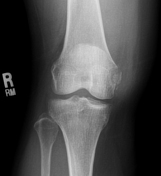Items tagged “knee”
420 results found
Article
Knee capsule
The knee capsule is a dual-layered structure that surrounds the knee joint. It is relatively thin anteriorly and posteriorly and thickened laterally by the collateral ligaments.
Gross anatomy
The outer layer of the knee capsule consists of fibrous connective tissue to hold the joint in place,...
Article
Knee synovial membrane
The synovial membrane of the knee is the inner aspect of the knee capsule, which produces synovial fluid to aid in the lubrication of the knee joint. It is also reflected on to the articular margins of the femur, tibia and patella. It does not cover the menisci or the cruciate ligaments posterio...
Article
Knee bursae
Knee bursae are sacs surrounding the knee joint that are filled with synovial fluid. They facilitate movement and reduce friction where tendons or muscles pass over bony prominences. The knee bursae can be either communicating or non-communicating with the knee joint itself.
Gross anatomy
The...
Case
Intraneural ganglion cyst of the common peroneal nerve

Published
26 Aug 2015
65% complete
MRI
Article
Superficial infrapatellar bursitis
Infrapatellar bursitis (or clergyman's knee) occurs with inflammation of bursae around the insertion of the distal patellar tendon. The inflamed bursa may be:
superficial/subcutaneous: anterior to the distal patellar tendon
deep: posterior to the distal patellar tendon, in the region of the in...
Case
Proximal MCL osseous avulsion

Published
20 Nov 2014
91% complete
X-ray
Case
Knee joint effusion

Published
02 Dec 2014
86% complete
X-ray
Annotated image
Case
Fulkerson procedure

Published
10 Dec 2014
88% complete
X-ray
Article
Meniscal tear
Meniscal tears are the failure of the fibrocartilaginous menisci of the knee. There are several types and can occur in an acute or chronic setting. Meniscal tears are best evaluated with MRI.
Pathology
Acute meniscal tears occur after the rotatory trauma of the knee, whereas chronic degenerati...
Article
Two-slice-touch rule (knee MRI)
The two-slice-touch rule is a sign on MRI of the knee used to increase the sensitivity of diagnosing meniscal tears.
This rule states a meniscal tear is present if abnormal findings are present on two or more images - these do not have to be contiguous, e.g. can occur on sagittal and coronal sl...
Article
Ultrasound of the knee
Ultrasound of the knee allows high-resolution imaging of superficial knee anatomy while simultaneously allowing dynamic evaluation of some of the tendons and ligaments. Knee ultrasound is somewhat limited compared with ultrasound examinations of other joints because the cruciate ligaments and th...
Article
Ring meniscus
A ring meniscus is a very rare anatomical variant of the lateral meniscus of the knee. The inner margin of a ring meniscus on coronal images can easily be mistaken for a bucket-handle meniscal tear displaced into the intercondylar space, so it is usually diagnosed during arthroscopy.
Case
Osgood-Schlatter disease

Published
07 Jan 2015
85% complete
X-ray
Case
Medial tibial plateau fracture

Published
19 Jan 2015
83% complete
X-ray
CT
Case
Tibial enchondroma

Published
24 Feb 2015
95% complete
CT
X-ray
Article
Meniscal ossicle
Meniscal ossicles are uncommon, often incidental, findings on radiography and cross-sectional imaging of the knee.
Epidemiology
Reported to have a prevalence of 0.15% in the general population 2.
Clinical presentation
maybe an incidental finding
may present with intermittent pain
joint loc...
Article
Ottawa knee rules
The Ottawa knee rules are a clinical decision-making strategy for determining which patients require radiographic imaging for knee pain following trauma.
A patient with knee pain qualifies for knee radiographs if any of the following apply:
55 years or older
point tenderness at the fibular he...
Article
Pittsburgh knee rules
The Pittsburgh knee rules are a clinical decision-making strategy for determining which patients require radiographic imaging for knee pain.
A patient with knee pain qualifies for a radiograph if:
fall or blunt trauma
<12 years old or >50 years old
inability to take four steps, regardless of...
Case
Segond fracture with anterior cruciate ligament and lateral meniscal tears

Published
25 Mar 2015
87% complete
MRI
X-ray
Case
Osteochondroma - sessile

Published
07 Apr 2015
90% complete
MRI
X-ray







 Unable to process the form. Check for errors and try again.
Unable to process the form. Check for errors and try again.